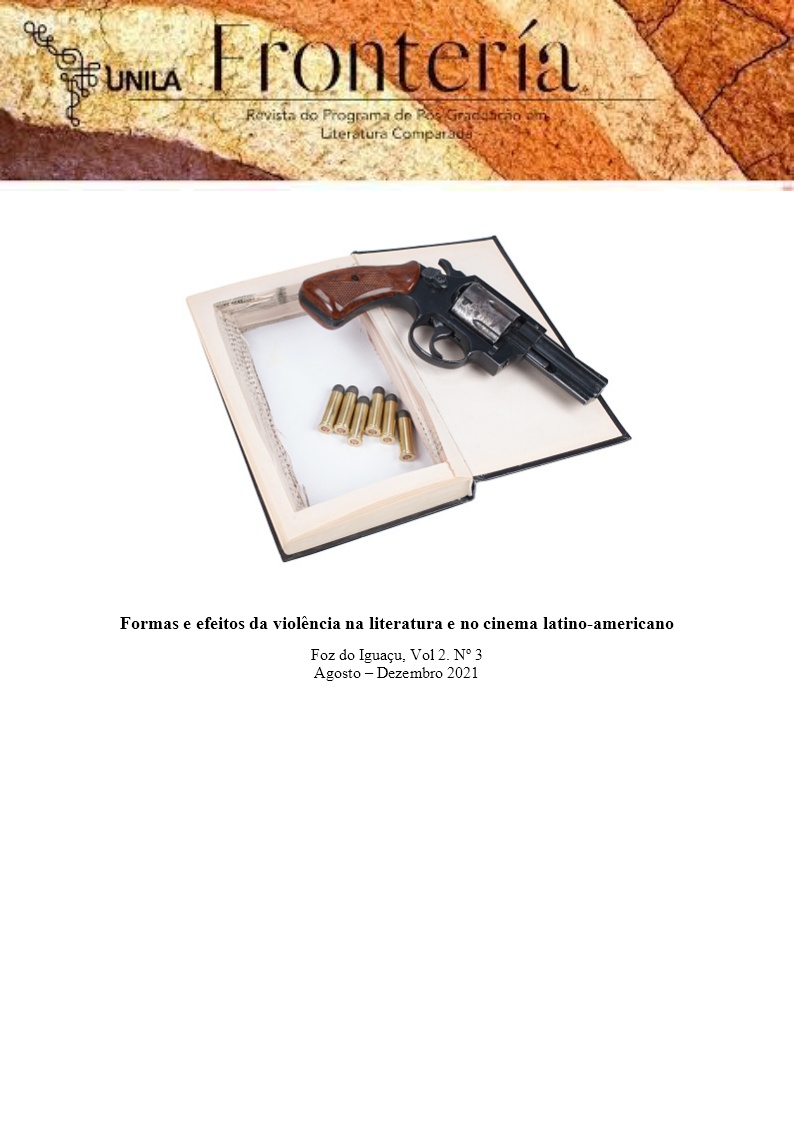Os brutos também amam? "Amores Perros" e o cinema mexicano contemporâneo
Keywords:
Cinema mexicano; fragmentação; violência; marginalização social; morte.Abstract
Both the subject of violence and marginalization including their social implications are recurrent in Latin American cinematography, which are discussed from different perspectives, commonly creative and even subversive. This article aims to analyze the Mexican movie Amores Perros (2000), directed by Alejandro González Iñárritu and written by Guillermo Arriaga, both belong to renewal movement of contemporary Mexican films. Aiming to this analyze under discussion were used mostly critical and theoretical works related to film studies. Firstly, this feature film is contextualized into the Mexican film industry and, after, analyzed as of its fragmentary construction and its relation to the themes such as violence, social marginalization and death. The fragmented structure of the movie, divided into three narrative segments, shows the reality of various characters connected by chance, a car accident. From this accident, the viewer follows the story of three mainly narratives and their confrontation with the consequences of the car accident and their own dilemmas. Beyond the excellent screenplay, whose plot reveals meaningful metaphors, editing, cinematography and camera movements stand out by director team.
Downloads
References
ALTMAN, Robert. Introdução. In: CARVER, Raymond. Short Cuts. Cenas da vida. Rio de Janeiro: Rocco, 1994.
AMORES BRUTOS. Direção: Alejandro González Iñárritu. Roteiro: Guillermo Arriaga. México: Altavista Films, 2000. DVD (154 minutos), Dolby digital, colorido.
BERNINI, Emilio. El repliegue del cine latino-americano en la década de 1980. In: Enfoco, nº44, ano 06. San Antonio de los Baños: Ediciones EICTV, noviembre-diciembre 2013, p. 10-16.
BOLEWSKI, C. Nonlinear narratives: crossing borders between contemporary film, art and digital media practice. International Journal of the Arts in Society, nº6. , Leicestershire: Loughborough University, 2011, p. 239 - 250. Disponível em: https://core.ac.uk/download/pdf/288375091.pdf Acesso em: 08 fev. 2021.
BOOKER, M. Keith. Postmodern Hollywood: what’s new in film and why it makes us feel so strange. Westport: Praeger, 2007.
BORDWELL, David. Poetics of cinema. New York: Routledge, 2008.
CARRIÈRE, Jean-Claude. A linguagem secreta do cinema. Trad. Fernando Albagli; Benjamim Albagli. Rio de Janeiro: Nova Fronteira, 2014.
FRÍAS, Isaac León. Las imprecisiones de una noción. In: Enfoco, nº44, ano 06. San Antonio de los Baños: Ediciones EICTV, noviembre-diciembre 2013, p. 05-09.
GONZÁLEZ, Concepción Maldonado. Diccionario de uso del español actual. 3ª edição. Prólogo de Gabriel García Márquez. Madri: Ediciones SM, 1999.
IMBERT, Gérard. Cine e imaginario sociales. El cine posmoderno como experiencia de los límites (1990-2010). Madrid: Cátedra, 2017.
KARAM, Tanius. Modos de experienciar la muerte en el cine de González Iñárritu. In: Quórum Académico, vol. 16, nº 2. México: Universidad del Zulia, 2019, p. 9-33. Disponível em: https://www.redalyc.org/jatsRepo/1990/199061671002/html/index.html. Acesso em: 02 fev. 2021.
KOSIK, Karel. Dialética do concreto. Trad. Célia Neves e Alderico Toríbio. Rio de Janeiro: Paz e Terra, 2002.
LEHNEN, Jeremy. Marginality, Mayhem and Middle-Class Anxieties: Imaginaries of Masculinity and Urban Violence in Contemporary Mexican and Brazilian Film. 2010, 296 f. Tese de doutorado. Albuquerque, The University of New Mexico, 2010.
MCKEE, Robert. Story: substância, estrutura, estilo e os princípios da escrita de roteiros. Trad. Chico Marés. Curitiba: Arte & Letra, 2006.
MIQUEL, Ángel. Panorama del cine mexicano contemporáneo. In: Inventio, nº4, vol. 2, p.80-86. Disponível em: http://inventio.uaem.mx/index.php/inventio/article/view/198/337. Acesso em: 16 fev. 2021.
NIETSZCHE, F. Fragmentos Póstumos. Tradução Oswaldo Giacoia Junior. Textos Didáticos, IFCH/UNICAMP, n.22, abril de 1996.
PAZ, Octavio. Vuelta. Barcelona: Seix Barral, 1976.
PARANAGUA, Paulo Antonio. Tradición y modernidad en el cine de América Latina. México: Fondo de Cultura Económica, 2003.
ROCHA, Glauber. Revolução do Cinema Novo. São Paulo: Cosac & Naify, 2004.
RUEDAS, Amanda. 1989-2008 – 20 años de cine latinoamericano: tendencias y evoluciones. In: Cinémas d’Amérique Latine, nº16, 2008, p.18-31. Disponível em: https://journals.openedition.org/cinelatino/2036?lang=es. Acesso em: 10 mar. 2021.
VIANA, Mauro Giuntini. A narrativa cinematográfica de Alejandro González Iñárritu. 313 f. Tese (Doutorado em Comunicação) Universidade de Brasília: Brasília, 2015.
Downloads
Published
How to Cite
Issue
Section
License
O envio dos trabalhos implica a cessão imediata e sem ônus dos direitos de publicação para a revista. O autor é integralmente responsável pelo conteúdo do artigo e continua a deter todos os direitos autorais para publicações posteriores do mesmo, devendo, se possível, fazer constar a referência à primeira publicação na revista. Esta não se compromete a devolver as contribuições recebidas. Destaca-se, ainda, que a revista é filiada ao sistema CreativeCommons, atribuição CC-BY (https://creativecommons.org/licenses/by/4.0/).




